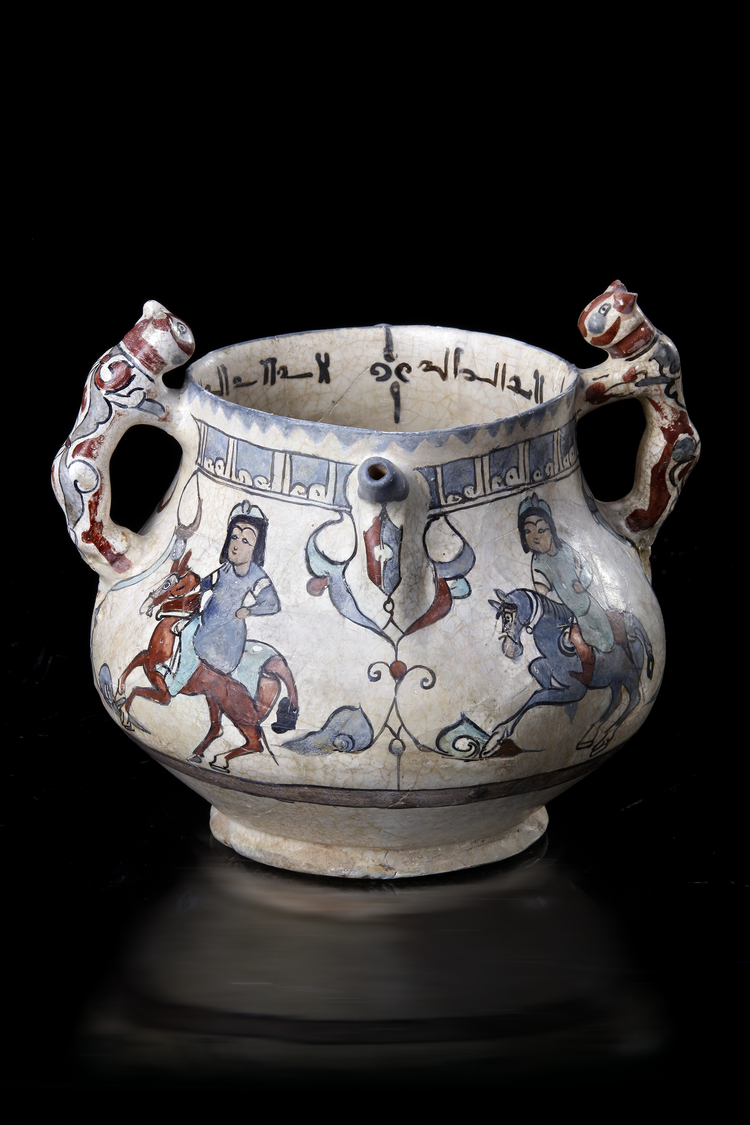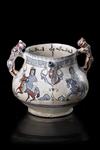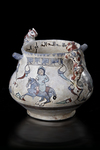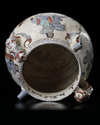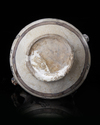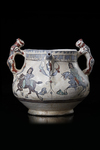* AN ISLAMIC VASE WITH ZOOMORPHIC HANDLES, PERSIA, KASHAN, LATE 12TH-EARLY 13TH CENTURY
Siliceous paste.
The thin-walled, fragile vase is supported by a small annular foot; its spherical but squashed body ends in a vertical rim. The two handles are modelled in the shape of panthers arranged vertically, the hind legs resting on the body of the vase and the front ones higher up, near the lip. The potter added two cylindrical false necks, shaped like the neck of a swan, at the rim and between the handles. Their purpose was probably decorative, as they are not pierced towards the inside of the vase.
The painted scene and its rich polychromy, based here on the use of blue, reddish-brown and sky-blue, brown and black, on the greyish-white surface of the vessel, are typical elements of the Islamic ceramic style known as minai. The frieze, which runs the full length of the available space, features four horsemen on their mounts, riding towards the viewer's left: they are separated by polychrome geometric motifs. An inscription imitating Arabic characters adorns the inside of the border. The riders are dressed in a sleeved tunic and wear trousers; their feet are slipped into the stirrups.
The ceramics, known as minai (a Persian term in modern usage meaning glazed) or haft-rang (Persian for "seven colours"), use the technique known as petit feu decoration, a highly elaborate process that sometimes involves up to three different firings: one for the paste and glaze, another for the metallic lustre, when present, and the last to fix the colours.
In vogue for only a few decades between the end of the 12th and the beginning of the 13th century AD, minai ceramics represent one of the most important developments in Islamic ceramics: its centre of production was in Kashan, in central Persia.
The technical difficulties involved in making these vessels and the fragility of the finished product meant that they were highly luxurious objects intended exclusively for the wealthier classes.
Complete and in good condition, but glued back together from a large number of fragments; frequent re-filling and paint retouching.
Height: 17.5 cm.
PROVENANCE
Private collection, Switzerland.
Formerly Japanese collection, collected in the 1980-90s.
BIBLIOGRAPHY
Terres d'Islam, Les collections de céramique moyen-orientale du Musée Ariana à Genève, Geneva, 2014, nos. 70-72, pp. 84-85.
VON FOLSACH K., The David Collection, Islamic Art, Copenhagen, 1990, pp.76, 99, no. 115.
WATSON O., Ceramics from the Islamic Lands, Kuwait National Museum: The Al-Sabah Collection, London, 2004, pp.364ff.
- SPECIAL NOTICE This lot is imported from outside the EU for sale using a temporary import regime. Import VAT is payable (at 9%) on the hammer price. The 30% buyers premium is subject to 21% VAT for EU citizens. When the buyer of this is registered an EU address but wishes to export the lot or complete the import into another EU country he must contact Oriental Art Auctions after the auction.
